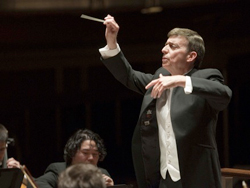by Robert Rollin

Notwithstanding the concerto focus, the highpoint of the evening was reached in Sergei Prokofiev’s magnificent Symphony No. 5 in B-flat, op. 100. The four-movement work was composed in summer, 1944, and came to being in the wake of a major Soviet victory over the Nazis. Though there is no specific program, the composer stated that he “wanted to sing the praises of the free and happy man — his strength, his generosity, and the purity of his soul.” It may best be characterized as displaying joy and enthusiasm for humanity and its future.
A full string complement, woodwinds by three, a large brass section underpinned by an active tuba part, and five percussionists filled up the Severance Hall stage.
The long first movement, Andante, began with flute and bassoon, soon engulfed by the string section. Tubas and other low instruments entered with a new idea that combined contrapuntally with the opening. The flute and oboe presented the more emotional second theme accompanied by nervous tremolo strings. After two powerful closing themes, the development concentrated on the first theme opening and on one of the closing themes. The recapitulation started with marvelous full brass proclaiming the first theme.
The tuba, bass drum, and timpani initiated the coda, which had the first of the piece’s great growth waves to end the movement.
The Symphony seemed anchored to its great second movement, Scherzo, marked Allegro marcato, a powerful and energetic piece possessing extensive low register support in contrabassoon, trombones, tubas, string basses, the powerful piano part, timpani and bass drum. The performance was excellent. The piquant clarinet solo tune spiced up the first section’s many variations, and clarinet and violas propelled the march-like middle-section’s triple meter. This middle section was encased in a blatant woodwind-dominated phrase. The next section had a prolonged growth, with a pile up of orchestration, a long crescendo, and amazingly propulsive energy. The opening material returned to close this joyous movement. The orchestra played with great ensemble and fine intonation.
The third movement, Adagio, in ABA form, continued the low register emphasis. Clarinets soared affectively over the low instruments to begin the two outer sections. The middle section tuba theme was sensitively played. The opening melody returns in the beautiful high strings, followed by the lovely coda. The finale, Allegro giocoso, began without pause on the first movement opening material, now presented as a conversation between woodwinds and strings, followed by a chorale-like texture in the cellos. A multiplicity of ideas helped propel this wonderful movement, as the skillful principal clarinet seemed to herald each new section. Another powerful coda returned to early ideas to close this fine performance of a true masterpiece.
The Edvard Grieg Concerto for Piano and Orchestra in a, op. 16 seemed rather slight in the shadow of the Prokofiev, despite an excellent performance by soloist I-Chieh Wang and the Orchestra. From the piano’s dramatic opening, Wang played with great poise and sensitivity throughout. Her flawless technique was constantly in evidence. The cellos and woodwinds particularly shone in the gorgeous first movement’s third theme. Wang’s poise, expression and gutsy energy were especially notable in the movement’s extended cadenza. The piano’s accelerando, its meticulous trills, a fine first horn solo, excellent woodwind solos, and sensitive string section playing all enlivened the second movement. The fast third movement followed without pause. A slow and sensitive piano solo was preceded and followed by the movement’s joyous first theme. Wang’s cadenza was again beautifully executed.
Modest Mussorgsky’s lovely Prelude to the Opera Khovanshchina (Dawn on the Moscow River), in Rimsky-Korsakov’s lovely orchestration, opened the concert.
A delicate start with clarinet solo, the lovely sostenuto sounds of two flutes, and a fine oboe solo were a bit marred by several cracked notes in the horns. The cello section truly shone in its foreground theme, and the folk-song-like modal theme beautifully expressed the atmosphere of the dawn. The short, charming piece had a delightful orchestration as brought out in this effective performance.
Published on ClevelandClassical.com April 1, 2013
Click here for a printable version of this article.


